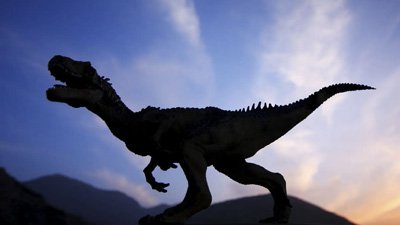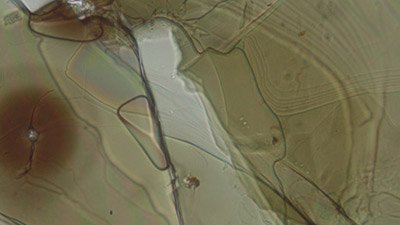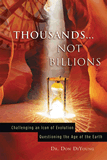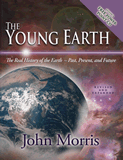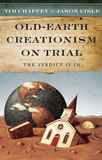Age of the Earth
The Bible and an Old Earth
Inserting vast ages into the Bible’s first chapter sets it at odds with modern secular scientific opinion regarding the order of events. Old-earthers put land mammals before whales contrary to biblical claims. Many such examples show it is impossible to add long periods of time into the biblical account without seriously damaging the doctrine of inerrancy.
Does the Earth Look Old?
Most people, including Christians, still claim dogmatically that the earth looks old. If we look at the earth through the “glasses” of human reasoning—that only snail-paced present geological processes can explain the past—then the earth does indeed look old. However, that autonomous human reasoning blatantly denies what God’s Word clearly tells us.
Noah’s Flood or Millions of Years, It Can’t Be Both
Either the rock record is the evidence of millions of years, or it is largely the evidence of Noah’s Flood. It can’t be both. If we believe the earth is billions of years old and shows no sign of a worldwide Flood, then that belief contradicts the biblical account of Noah. If we accept God’s testimony regarding the Flood, we cannot logically believe in millions of years.
“Scientific” Arguments for an Old Earth
We commonly hear scientific-sounding arguments that the earth and universe are billions of years old. We are told radiometric dating shows that certain rocks formed billions of years ago. We are told that starlight from distant galaxies takes billions of years to arrive on earth. Do these arguments stand up to scrutiny?
Evidences of a Young Earth
The earth is only a few thousand years old. That’s a fact, plainly revealed in God’s Word. So we should expect to find plenty of evidence for its youth. And that’s what we find in the earth’s geology, biology, paleontology, and even astronomy.
Age of the Earth Topics
-
Why Does Creation Matter?
Is creation vital to the authority of Scripture and the gospel, or are we just wasting our time and being divisive—or worse, turning people away from Christ?
-
Age of the Universe
Scientists often proclaim that they have “proved” that the universe is billions of years old, but does the observational science support this assertion?
-
Bible Genealogy
The genealogies of the Bible are used to construct a biblical chronology and timeline of 6,000 years, but can these genealogies be trusted?
-
Carbon-14
Carbon, which dissipates in just tens of thousands of years, is present in diamonds and fossils! Carbon-14 calls the whole old-earth paradigm into question.
-
Days of Creation
Did God really create everything in six literal, 24-hour days? A study of the Hebrew text and biblical teaching as a whole reveals that He did!
-
Death Before Sin?
Genesis 1 reveals that God’s original creation was “very good.” Death and suffering are the result of Adam’s sin—we can’t blame God for it.
-
How Are Fossils Formed?
Do fossils really require millions of years to form? The evidence shouts no! A lot of water and a little bit of time rapidly laid down the fossil record.
-
Is the Bible True?
The Bible claims to be written by God—through human authors—but can we trust it as error-free and authoritative on everything it touches?
-
Millions of Years
The evolutionary timeline of millions of years is not compatible with the Bible or with the scientific evidence.
-
Molecular Clock
Do studies that use mutation rates to calibrate a “molecular clock” confirm or deny the evolutionary model? Are the assumptions in such calibrations correct?
-
Radiometric Dating
How does radiometric dating work? Does radiometric dating prove rocks are millions or billions of years old?
-
Rock Layers
Do rock layers prove the earth is billions of years old? How does what we see in the world match what we read in God’s Word?
-
Starlight
How could distant starlight from millions of light years away reach earth if the universe is only around 6,000 years old, as the Bible reveals?
-
When Did Dinosaurs Live?
Did dinosaurs live millions of years ago, or have these impressive creatures existed much more recently? Could some even be alive today?
News About Age of the Earth
-
Nov. 19, 2018 from Answers News
Matt Walsh misses the heart of the issue in his rebuttal of Ken Ham and young-earth creation.
Articles About Age of the Earth
-
Oct. 1, 2025 from Answers Magazine
The design of nature certainly declares something about the Creator. But is it a “sixty-seventh book” of the Bible?
-
Feb. 21, 2024 from Answers in Depth
The only reliable way to calibrate dating methods is with the Bible’s history.
-
Nov. 26, 2023 from Answers Magazine
Where’s the supposed evidence that the earth is 4.54 billion years old? It’s not on earth at all!
-
March 8, 2022 from Answers Magazine
For more than 100 years oil has been the “black gold” that has fueled transport vehicles and powered global economic growth and prosperity. So how does oil form, and what is its origin?
-
Nov. 14, 2021 from Answers Magazine
Every year, the moon moves an inch or so farther away from earth. It may not seem like much, but that tiny movement puts a big limit on the moon’s age.
-
Aug. 8, 2021 from Answers Magazine
Helium diffuses so rapidly that all the helium should have leaked out of rocks in less than 100,000 years.
-
June 18, 2021 from Answers in Depth
Study suggests earth's early atmosphere had enough oxygen for complex life but ignores hidden assumptions, alternative evidence & Scripture regarding creation.
-
June 16, 2021 from Answers in Depth
How reliable is the tree ring data, and can it be conclusively proven that some trees (like Bristlecone Pines) only produce a single growth ring per year?
-
March 20, 2021 from Ken Ham Blog
William Lane Craig & Phil Vischer attack Ken Ham for believing the Bible about rejecting evolution indicating ongoing compromise in the Evangelical church.
-
Dec. 15, 2020 from The New Answers Book 4
Can a person believe in an old earth and an old universe (millions or billions of years in age) and be a Christian? Find out what the Bible says.
-
Nov. 14, 2020 from Answers in Depth
This is a summary of the historical development of the modern uniformitarian view of the geological record and the millions-of-years time-scale.
PDF Download -
Oct. 31, 2019 from The New Answers Book 4
The Reformers taught that God revealed in Genesis that He created all things in six ordinary days about six thousand years ago.
-
Nov. 10, 2018 from The New Answers Book 3
Most people, including Christians, would still claim dogmatically that the earth looks old. But why does the earth supposedly look old?
-
May 22, 2018 from Answers Magazine
Secular scientists claim it’s easy to disprove the Bible’s 6,000-year history: just count the tree rings. Is this dating method reliable?
-
May 12, 2018 from Answers Magazine
A 6,000-year-old earth? When you look up the Bible references, the math’s not that hard!
-
Oct. 14, 2017 from Essays on Origins: Creation vs. Evolution
Interpretation of the Hebrew word yom in Genesis 1–2 has become one of the most contested issues among professing Christians and Jews.
-
Richard Dawkins Says He Despises Young-Earth CreationistsMay 19, 2015
That’s why Richard Dawkins despises young-earth creationists—he recognizes the incredible threat they are to his atheistic religion.
-
Semi-TechnicalA Response to a Gospel Coalition Blog on the Age of the EarthApril 22, 2015
In a blog post for The Gospel Coalition, Justin Taylor presented his reasons for doubting that the days of creation in Genesis 1 were literal 24-hour days.
-
Technical In-Depth ArticleMore Evidence of Rapid Geomagnetic Reversals Confirms a Young EarthJan. 8, 2015 from Answers in Depth
Explore stunning evidence consistent with the young-earth model for the earth’s geomagnetic polarity reversal during the Flood and its aftermath.
-
Magazine Department ArticleCrystal Clear?July 1, 2014 from Answers Magazine
Evolutionary scientists say they have confirmed that 4.4 billion years is the age of the earth’s earliest rocks.
-
In-Depth Article“Fossil Galaxy” Said to Show Conditions Soon After the Big BangMay 17, 2014 from Answers in Depth
Are the chemical signatures in a faint galaxy the fossil remnants of our universe’s birth?
-
Cosmos Review: “The Clean Room”April 22, 2014 from Countering the Culture
This episode tells the story of “one man’s quest” to discover what host Neil deGrasse Tyson assures viewers (six times) is the “true age of the Earth.”
-
April 9, 2014 from Answers Magazine
Granite rocks exhibit mysterious black spheres, known as radiohalos.
-
April 1, 2014 from Answers Magazine
The tiny black flecks found in granite testify to a powerful and recent worldwide Flood. But you have to look closely.
-
Feedback ArticlePat Robertson’s Word or God’s Word: Which Will You Believe?Nov. 30, 2012 from Feedback
On a recent episode of the 700 Club program on the CBN TV network, Pat Robertson made a very sad and disturbing statement.
-
Untestable Age of the Earth Becomes PoliticalNov. 24, 2012 from News to Know
Untestable age of the earth becomes contestable political litmus test.
-
Feedback ArticleDebating with an Evolutionist on Fossil DatingAug. 10, 2012 from Feedback
Dr. Andrew Snelling, AiG–U.S., responds to a reader and gives more information regarding the fossilized wood on top of fossil belemnite.
-
Book ChapterDefense—“Scientific” ArgumentsFeb. 23, 2012 from Old-Earth Creationism on Trial
In this chapter, we will examine the most common scientific arguments for an old earth.
-
Book ChapterDefense—“Biblical” ArgumentsJan. 5, 2012 from Old-Earth Creationism on Trial
Several well-known evangelical leaders have offered arguments against young-earth creationism. It is surprising to see the very inadequate responses from otherwise brilliant men.
-
Book ChapterAn IntroductionDec. 22, 2011 from Old-Earth Creationism on Trial
With the resurgence of young-earth creationism in recent decades, the debate over the age of the earth and the proper hermeneutical approach to Genesis has intensified within evangelical circles.
-
Feedback ArticleGently Confronting GrandfatherSept. 9, 2011 from Feedback
While we do not harshly criticize those who are in error, we are told to warn or advise them. Tim Chaffey, AiG–U.S., writes about gently confronting our fellow believers.
-
Book ChapterDating MethodsJan. 6, 2011 from Evolution Exposed: Earth Science
Most scientists and many Christians believe that the radiometric dating methods prove that the earth is 4.5 billion years old. Recent research shows otherwise.
-
The Emotional Age IssueNov. 15, 2010 from Answers Update
In 35 years of ministry, I’ve discovered that the issue of the age of the earth and the universe is an extremely emotional topic for secularists.
-
Semi-Technical In-Depth ArticleSummary of a Response to “PCA Geologists on the Antiquity of the Earth”Aug. 18, 2010 from Answers in Depth
Eight geologists argue that Christians should reject Noah’s Flood as being geologically insignificant and adopt an old-earth view of Genesis.
-
Semi-Technical In-Depth ArticleA Response to the Old-Earth Advocacy of Campbell et al., PCA Geologists on the Antiquity of the EarthAug. 18, 2010 from Answers in Depth
This response was developed to demonstrate to laymen that the arguments of old-earth geology are neither based on proper authority nor are scientifically compelling.
-
Feedback ArticleDoes Sand Prove Long Ages?July 9, 2010 from Feedback
Dr. Andrew Snelling, AiG–U.S., gives a young earth creation explanation of the formation of beaches and other sands.
-
Feedback ArticleRevisiting Bristlecone Pines and the BibleMarch 13, 2009 from Feedback
A procurement forester offers his thoughts on tree growth rings and the biblical chronology. John Woodmorappe responds.
-
Semi-Technical In-Depth ArticleBiblical Chronology and the 8,000-Year-Long Bristlecone Pine Tree-Ring ChronologyJan. 28, 2009 from Answers in Depth
The Bristlecone Pine long chronology, comprised of hundreds of live and dead trees, is claimed to be over 8,000 years long. But is there more to the story?
PDF Download -
Oct. 13, 2008 from Answers Magazine
Most of these Christians ignore the account of Noah’s Flood in Genesis 6–9 and its implications for understanding the geological history of the earth.
-
New Set of Oldest Rocks Found In CanadaOct. 4, 2008
Humbly lying on the tundra shores of Canada’s Hudson Bay are the world’s oldest rocks—4.28 billion years old, to be exact, maybe.
-
Feedback ArticleDid God Create the Earth to Look “Old”?Feb. 22, 2008 from Feedback
Does geological data “abundantly demonstrate” either that the earth is old or that God created it to appear old?
-
Book ChapterWhy Shouldn’t Christians Accept Millions of Years?Aug. 16, 2007 from The New Answers Book 1
Is the age of the earth unimportant and divisive, as some Christians claim? Answers in Genesis thinks not.
-
Semi-Technical In-Depth ArticleJesus, Evangelical Scholars, and the Age of the EarthAug. 1, 2007 from Answers in Depth
What did Jesus think about the age of the earth? Did He say anything during His earthly life that would reveal His thinking?
PDF Download -
Decay and Age: RocksMarch 17, 2007
Although many laypeople think of radiometric dating as unquestionably reliable, the truth is, many of the “ages” such dating methods suggest are contentious and contradictory.
-
Oct. 25, 2006 from Answers Magazine
One essential component of evolution is an extremely long timescale for earth history.
-
Whom Do You Trust?June 14, 2005
When dealing with the days of creation and the age of the earth, whom do Christians trust today?
Recommended Resources

Answers in Genesis is an apologetics ministry, dedicated to helping Christians defend their faith and proclaim the good news of Jesus Christ.
- Customer Service 800.778.3390
- Available Monday–Friday | 9 AM–5 PM ET
- © 2025 Answers in Genesis















